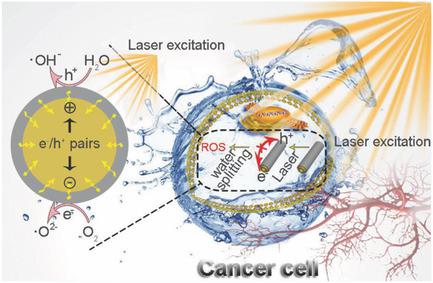当前位置:
X-MOL 学术
›
Adv. Healthcare Mater.
›
论文详情
Our official English website, www.x-mol.net, welcomes your
feedback! (Note: you will need to create a separate account there.)
Carbon‐Dot‐Decorated TiO2 Nanotubes toward Photodynamic Therapy Based on Water‐Splitting Mechanism
Advanced Healthcare Materials ( IF 10.0 ) Pub Date : 2018-03-12 , DOI: 10.1002/adhm.201800042 Dan Yang 1 , Guixin Yang 1 , Qianqian Sun 1 , Shili Gai 1 , Fei He 1 , Yunlu Dai 1 , Chongna Zhong 1 , Piaoping Yang 1
Advanced Healthcare Materials ( IF 10.0 ) Pub Date : 2018-03-12 , DOI: 10.1002/adhm.201800042 Dan Yang 1 , Guixin Yang 1 , Qianqian Sun 1 , Shili Gai 1 , Fei He 1 , Yunlu Dai 1 , Chongna Zhong 1 , Piaoping Yang 1
Affiliation

|
The use of visible light to produce reactive oxygen species (ROS) from renewable water splitting is a highly promising means in photodynamic therapy (PDT). Up to date, diverse inorganic–organic hybrid materials developed as photosensitizers still undergo low therapeutic efficiency and/or poor stability. Herein, a kind of carbon‐nanodot‐decorated TiO2 nanotubes (CDots/TiO2 NTs) composite is developed and applied for photodynamic therapy. Upon 650 nm laser light excitation, the emissions with short wavelengths (325–425 nm) from the CDots as a result of upconversion process excite TiO2 NTs to form electron/hole (e−/h+) pairs, triggering the reaction with the adsorbed oxidants to produce ROS. Moreover, the CDots deposited on the surface of TiO2 NTs markedly enhance the light absorption response and narrow the band gap compared with anatase TiO2 nanoparticles, thereby increasing the photosensitizing efficiency. Besides, the CDots show high chemical catalytic activity for H2O2 decomposition even if no light is needed, which is essential for PDT. The excellent therapeutic performance actuated by 650 nm light is demonstrated by in vitro and in vivo assays. This photosensitizer comprises low‐cost, earth‐abundant, environment‐friendly merits, and especially excellent stability, implying its feasible application in biomedical field.
中文翻译:

基于水分解机理的碳点修饰TiO2纳米管对光动力治疗的影响
利用可见光从可再生水分解中产生活性氧(ROS)是光动力疗法(PDT)中极有希望的手段。迄今为止,作为光敏剂开发的各种无机-有机杂化材料仍具有治疗效率低和/或稳定性差的特点。本文开发了一种碳纳米修饰的TiO 2纳米管(CDots / TiO 2 NTs)复合材料,并将其用于光动力疗法。在650 nm激光激发光,与来自CDots短的波长(325-425纳米)作为上转换处理的结果的排放EXCITE的TiO 2的NT以形成电子/空穴(E - / H +)配对,触发与吸附的氧化剂的反应以生成ROS。此外,与锐钛矿型TiO 2纳米颗粒相比,沉积在TiO 2 NTs表面的CDots显着提高了光吸收响应并缩小了带隙,从而提高了光敏效率。此外,即使不需要光,CDots对H 2 O 2分解也显示出高化学催化活性,这对于PDT是必不可少的。650 nm光激发的出色治疗性能已通过体外和体内试验证明。该光敏剂具有低成本,富含地球,对环境友好的优点,尤其是优异的稳定性,这意味着它在生物医学领域的可行应用。
更新日期:2018-03-12
中文翻译:

基于水分解机理的碳点修饰TiO2纳米管对光动力治疗的影响
利用可见光从可再生水分解中产生活性氧(ROS)是光动力疗法(PDT)中极有希望的手段。迄今为止,作为光敏剂开发的各种无机-有机杂化材料仍具有治疗效率低和/或稳定性差的特点。本文开发了一种碳纳米修饰的TiO 2纳米管(CDots / TiO 2 NTs)复合材料,并将其用于光动力疗法。在650 nm激光激发光,与来自CDots短的波长(325-425纳米)作为上转换处理的结果的排放EXCITE的TiO 2的NT以形成电子/空穴(E - / H +)配对,触发与吸附的氧化剂的反应以生成ROS。此外,与锐钛矿型TiO 2纳米颗粒相比,沉积在TiO 2 NTs表面的CDots显着提高了光吸收响应并缩小了带隙,从而提高了光敏效率。此外,即使不需要光,CDots对H 2 O 2分解也显示出高化学催化活性,这对于PDT是必不可少的。650 nm光激发的出色治疗性能已通过体外和体内试验证明。该光敏剂具有低成本,富含地球,对环境友好的优点,尤其是优异的稳定性,这意味着它在生物医学领域的可行应用。











































 京公网安备 11010802027423号
京公网安备 11010802027423号